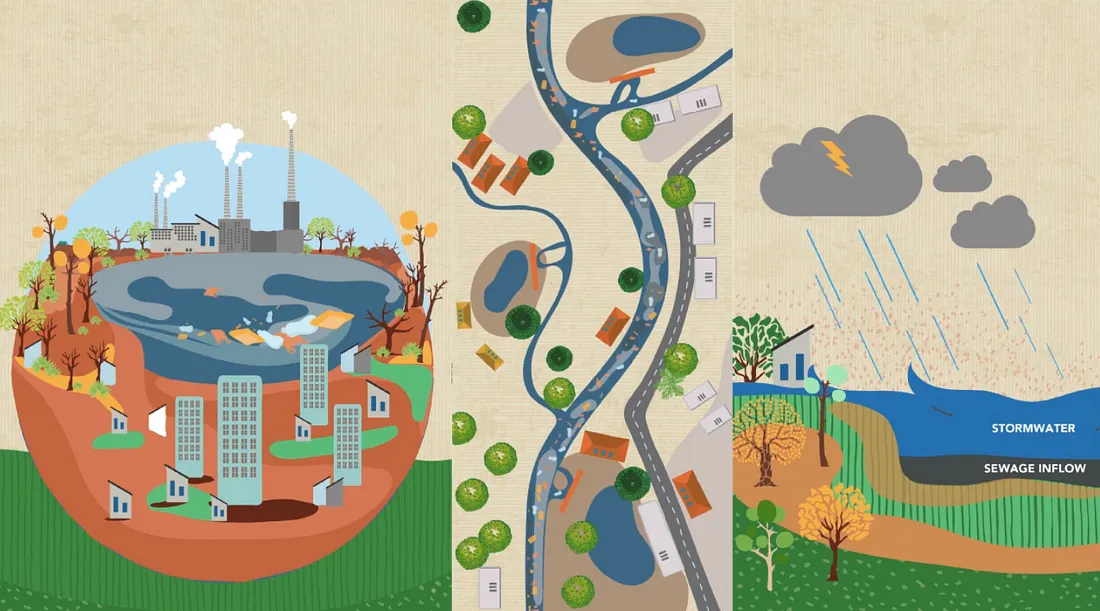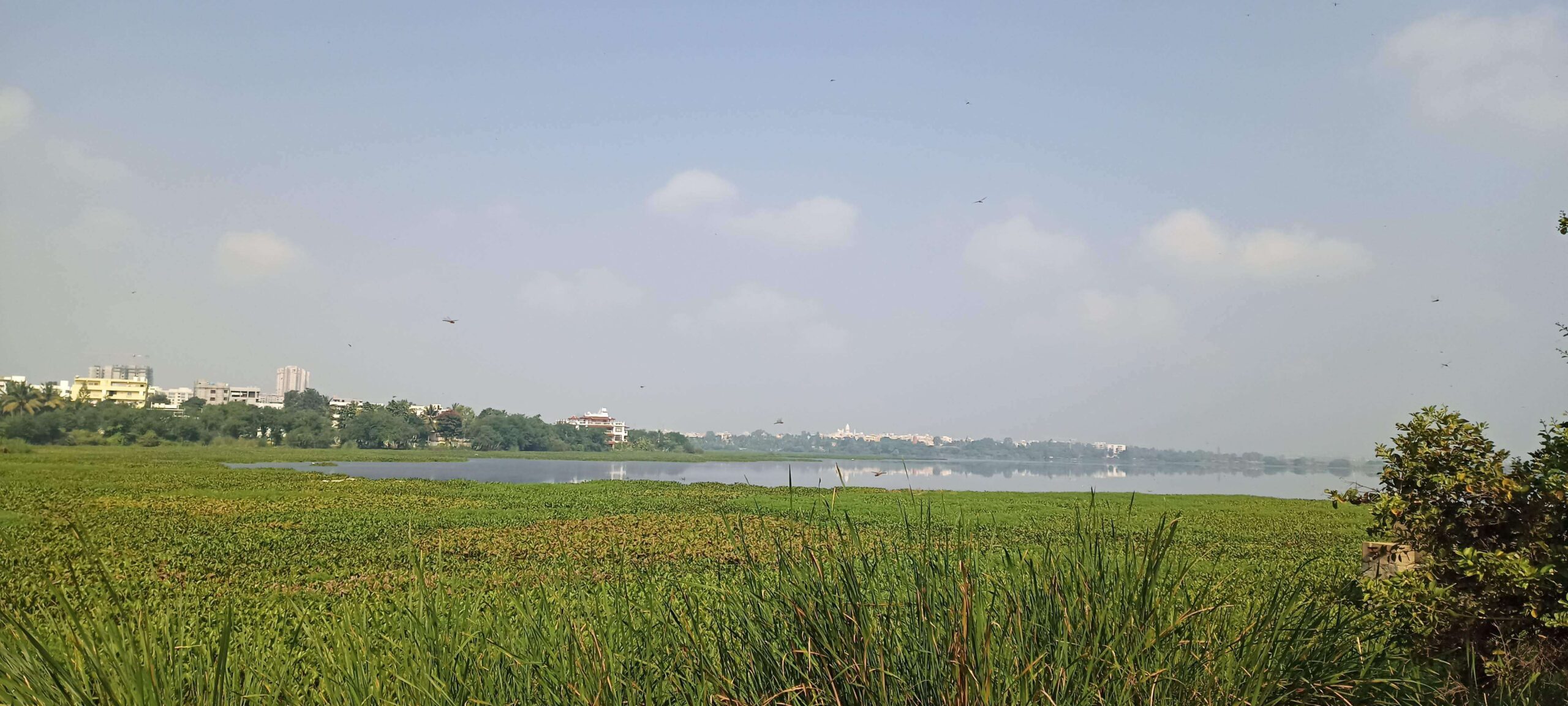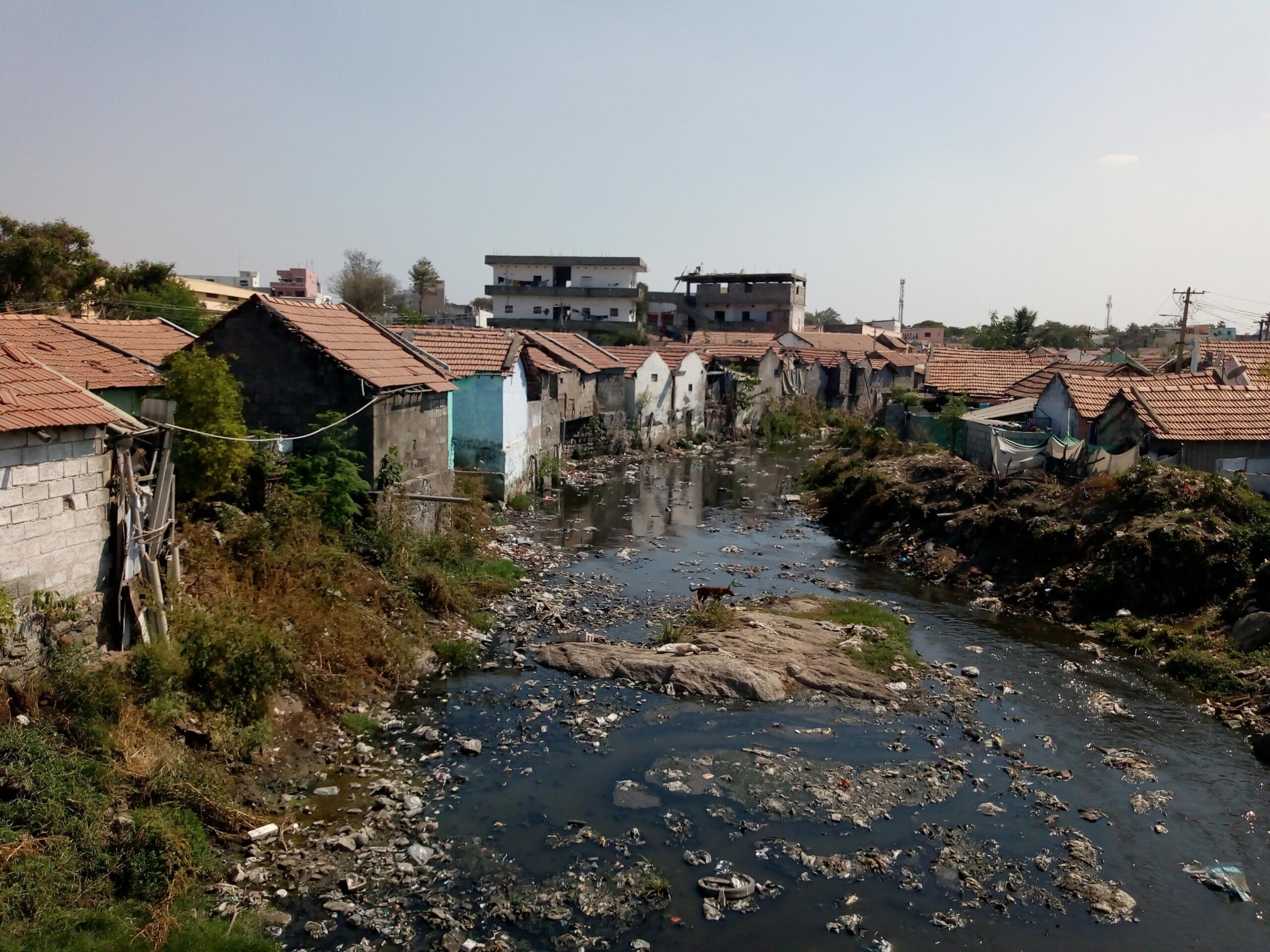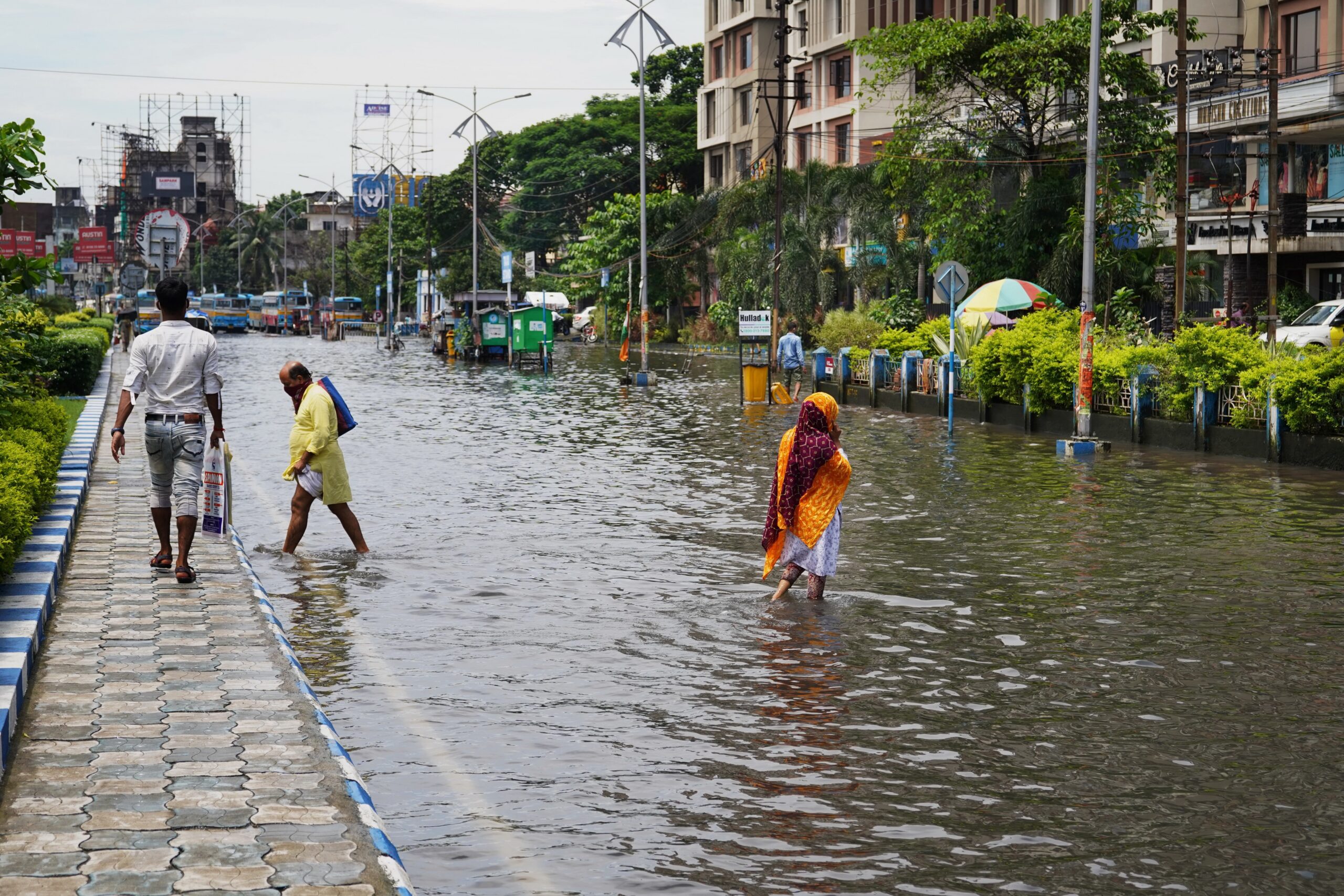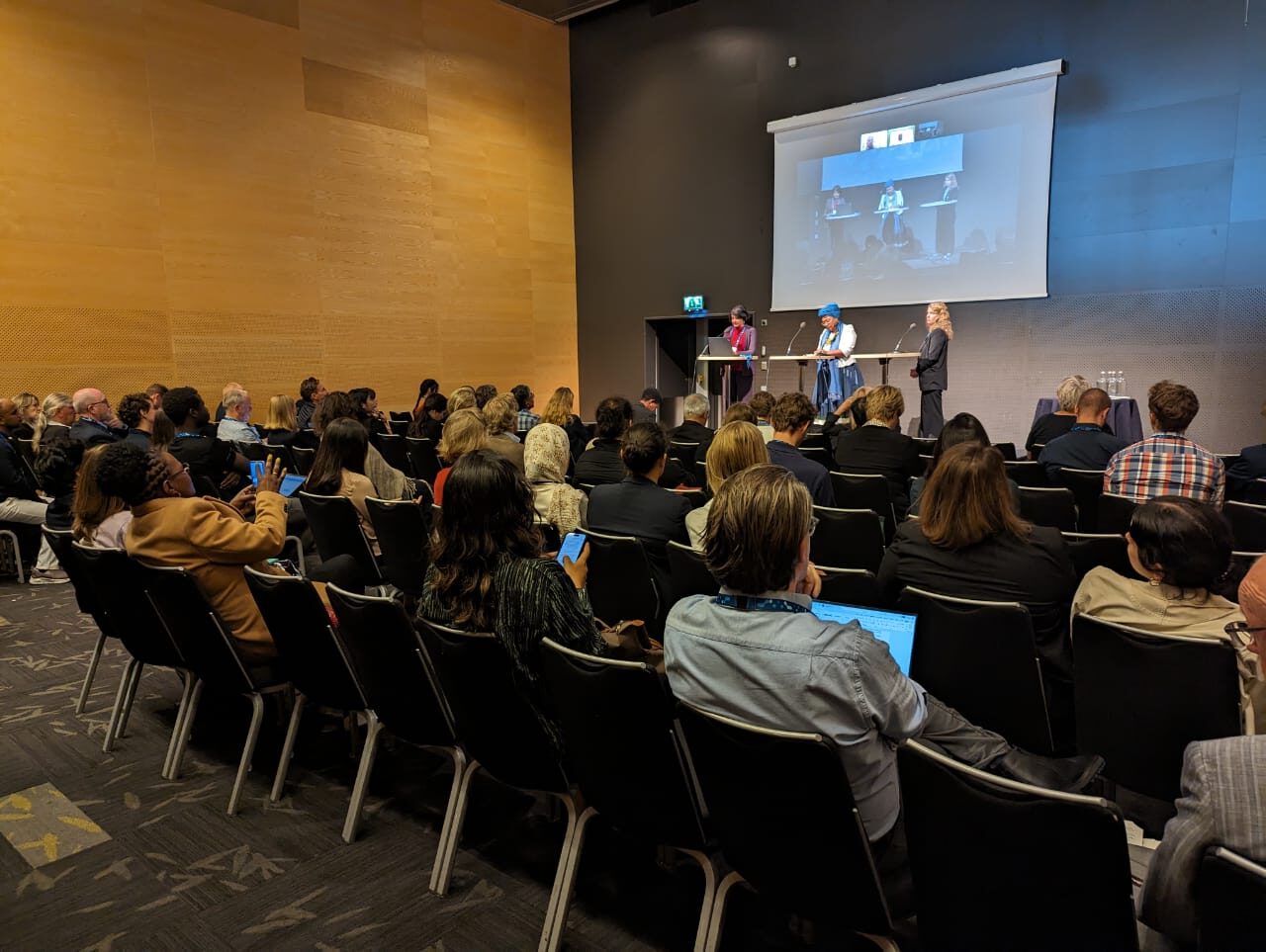Grey to Blue: What Can Bengaluru Learn From Chennai on Tertiary Treatment of Wastewater
This is the water pumping station at Porur lake. Credit: Shashank Palur.
Climate change is exacerbating water woes in Indian cities. For example, Chennai — like many rapidly growing cities in India — swings between the two extremes of floods and droughts. In December 2023, the city made headlines again for severe flooding in the wake of Cyclone Michaung. In the summer of 2019, the city declared ‘Day Zero’, when the Chennai Metropolitan Water Supply and Sewerage Board ran out of water to supply to the city’s 12 million residents. Reservoirs emptied and borewells ran dry, resulting in a historic drought.
There is a pressing need for Indian cities to work towards managing their water resources better, which is where reusing treated wastewater holds immense potential.
While watering green spaces is the most widely accepted reuse for treated wastewater, the real impact on freshwater savings would be by converting treated wastewater to potable quality. Currently, most of the excess treated wastewater and untreated sewage are discharged into lakes, thereby polluting them. If the treated wastewater were to instead be responsibly discharged into water bodies, it could be stored there, which would enable aquifers to be replenished and act as a source of potable water.
Day Zero’ in Chennai also triggered a rethink on how wastewater in the city is managed.
Part of the answer for the water crisis in Chennai lay in the campus of the Indian Institute of Technology, Madras. This establishment remained unfazed even as water supply was cut by half because they were self-sufficient. On campus, there was a treatment plant that had the capacity to treat four million litres per day (MLD) of domestic sewage to potable standards.
A 20-km-long pipeline laid throughout the campus distributed treated wastewater to the staff residence, hostel and academic blocks. Even though their total water requirement is 2.8 MLD, the campus sources only 1.2–1.8 million litres of freshwater supply from the city’s water utility. This is because they reuse treated wastewater for purposes like flushing, gardening and air conditioning, which accounts to 40% of the total water consumption.
The Chennai Metropolitan Water Supply and Sewerage Board (CMWSSB) set up their tertiary treatment ultrafiltration plant (TTUF) at Nesapakkam based on the IIT Madras example.
Chennai’s Nesapakkam plant converts raw sewage to potable drinking water.
The TTUF is designed to handle 10 million litres of sewage daily and was set up using a capital of ₹28 crore on a site area of 6,500 sq. m. Raw sewage treated up to the secondary stage is first put through a Sequence Batch Reactor (SBR) process — the water is treated through biological processes and filtration to remove the majority of physical and bacterial loads. Next, it undergoes tertiary treatment, such as ultrafiltration to remove the finer physical and chemical contaminants and ozonation to disinfect the water. Finally, the treated wastewater is passed through an activated carbon filter before it is sent to Porur Lake, the primary source of drinking water for about one lakh residents, through a surface pipeline network.
The operations and maintenance cost to treat one kilolitre of sewage at the TTUF works out to ₹18, while residents are currently paying an average of ₹80 per kilolitre to buy water supplied by tankers, which goes up to ₹150 per kilolitre in the summer to meet their water demand. Switching to tertiary treated wastewater would be an economic alternative to freshwater.
Based on our conversations with people who conceptualised and now run the plant, we identified three key aspects they got right and is worth weaving into planning of similar projects in other cities:
1. Open communication and awareness among stakeholders ensured sustained success:
Regular meetings between the area’s residents and the Chennai Metropolitan Water Supply and Sewerage Board ensured that all concerns and possible risks associated with reusing treated wastewater were discussed and addressed upfront. Awareness campaigns helped by addressing concerns regarding water quality and the treatment process.
People were reassured further by the usage of fish ponds within the treatment plant as a quality control check before the water was released into the lake because fish are extremely sensitive to any chemicals or effluents present in the water.
2. Good collaboration facilitated rapid implementation:
The involvement of experts from IIT Madras and the outcomes of the research conducted by them played a crucial role in the rapid implementation of the treatment plant. This project is the outcome of strong collaboration between the Government of Tamil Nadu, the city’s utility (Chennai Metropolitan Water Supply and Sewerage Board) and academia (IIT Madras).
3. Indirect potable reuse is more accepted than direct potable reuse:
Acceptance for reuse of treated water is higher for indirect potable purposes, as an environmental buffer (the lake) is present before the treated water makes its way into municipal supply.
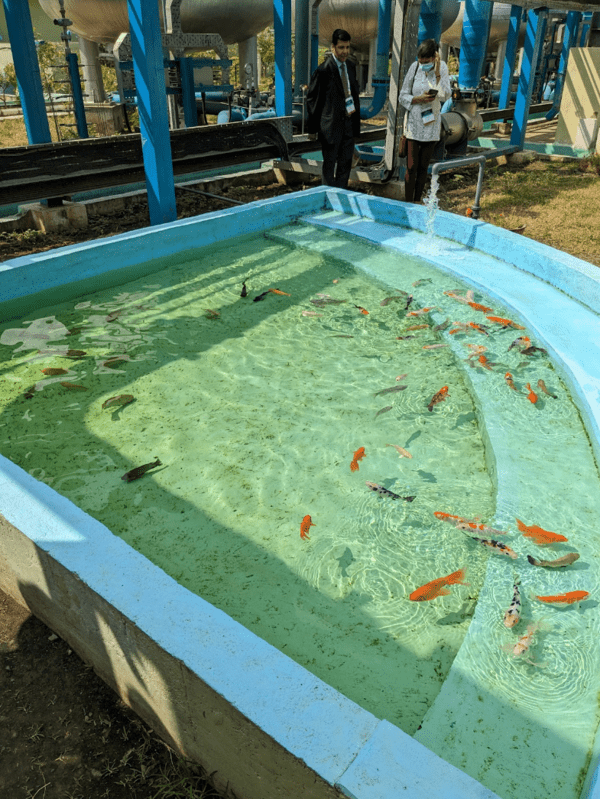
The fish pond acts as a quality check mechanism as they are highly sensitive to water quality.
The treated water is let into Porur lake, nine kilometres away from the sewage treatment plant (STP). The lake was desilted ahead of this project to allow for the maximum storage of stormwater and treated water. It has a storage capacity of 70 million cubic feet, which translates into a hundred days of buffer storage roughly. This means that the lake can continue to supply water in case the treatment plant is under maintenance. In essence, the residents use a blended form of treated and stormwater from the lake, which is additionally treated at a 4-MLD water treatment plant.
Let’s shift focus to the city of Bengaluru and look at the potential it holds to follow a similar reuse approach for treated wastewater and manage its water resources better.
Currently, there are a handful of TTUF- equipped centralised STPs managed by the Bangalore Water Supply and Sewerage Board (BWSSB), which can be upgraded to provide improved water quality. The 15-MLD-capacity STP at the head of Jakkur lake is a good example. This STP supplies treated water of varied quality for multiple reuse purposes on demand. Treated water of potable quality (tertiary treated) is supplied to a nearby gas power plant for cooling purposes, whereas the secondary treated water is discharged into the lake. Since the area around the lake barely has any municipal supply, it could serve as a sink for indirect potable reuse.
Additionally, the city sends secondary treated water to its neighbouring districts through a network of channels and lakes (~600 MLD). If the water is treated and reused, it can offset the amount of water imported from the Cauvery and reduce the burden on overexploited groundwater resources, which is essential as the water crisis of 2024 was mainly caused by groundwater running out. Bengaluru extracts over ten times the groundwater it recharges, so using treated wastewater would take the burden off the borewells in the city.
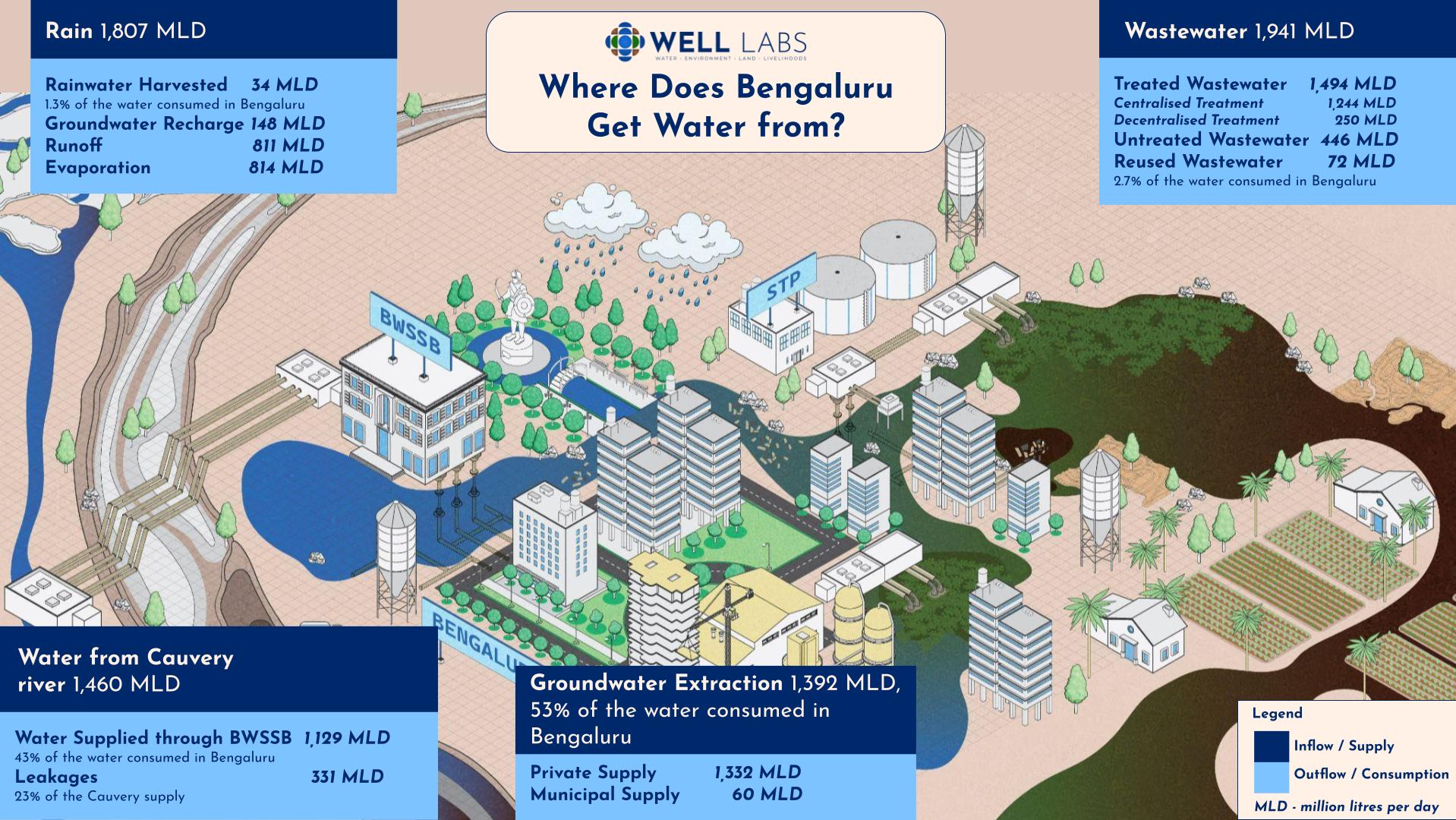
Groundwater and water from the Cauvery river are major sources of water supply for Bengaluru. However, increasing wastewater reuse could reduce the stress on limited freshwater supplies. Infographic and illustration designed by Sarayu Neelakantan.
A significant amount of leftover treated water is let into stormwater drains and lakes, which renders it unsafe and unusable for industrial use or construction work as it mixes with the untreated sewage present in water bodies. As a result, industries and construction, two big potential users of treated wastewater throughout the year, end up using groundwater extensively.
Given the current perception of treated wastewater and its quality, it is being reused only for greening and toilet flushing purposes. However, considering the current water demand, tertiary treated wastewater could be an alternative to freshwater for non-potable activities. Our projections reveal that reusing 100% of treated wastewater in Bangalore can reduce dependency on freshwater sources by more than 42%.
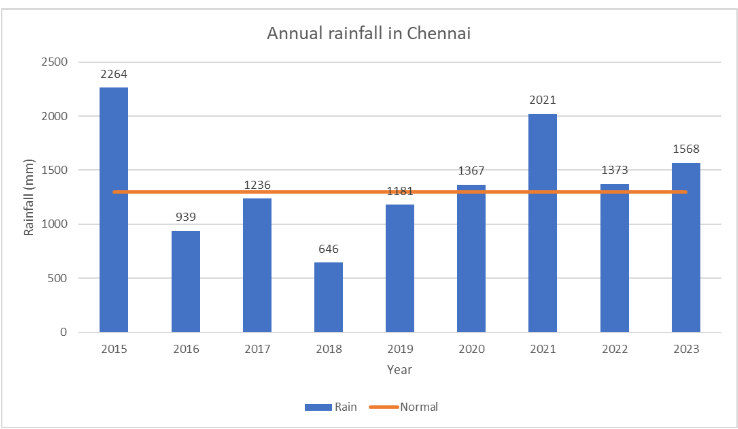
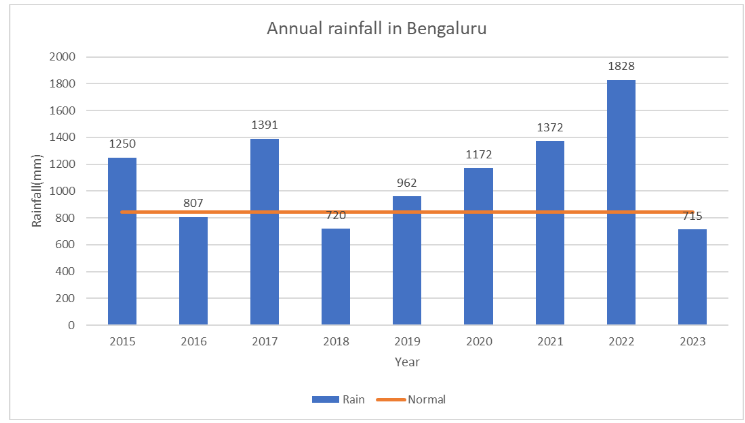
Left: Graph showing the annual rainfall in Chennai. Right: Graph showing the annual rainfall in Bengaluru
The last three years (2021 to 2023) show large variations in rainfall patterns and huge fluctuations from the average rainfall in Bengaluru. The years 2021 and 2022 saw extreme rainfall, which led to flooding in the city, whereas 2023 was a drought year, especially as the month of August was the driest August ever recorded since 1899, with only 12 mm of rainfall occurring compared to the 20-year average of 133 mm.
Given the noticeable fall in groundwater levels across Bengaluru, the implementation of initiatives similar to the Nesapakkam plant in Chennai will not only augment the city’s freshwater supply, but also recharge shallow aquifers with good quality water, minimising health risks of the dependent population.
The Government of Tamil Nadu is investing in multiple water treatment and reuse projects to address water scarcity and improve water quality in the city. Tertiary treatment plants with ultrafiltration of 10-MLD capacity each are being set up in Perungudi and Langs Garden and there are plans for another similar plant in Villivakkam that can process 5 MLD, currently at the tender stage. Additionally, the government is also planning to build two large reverse osmosis plants in Koyembedu and Kodungaiyur of 45-MLD capacity each for industrial use.
It’s important to acknowledge here that the histories and circumstances in both cities are different. Chennai has always faced water scarcity and its groundwater quality is generally much poorer than in Bengaluru. The need for alternatives has always been more acute, prompting the city to more proactively explore this alternative. But the summer of 2024 has brought into sharp focus what kind of impacts Bengaluru will face in a warming world.
India’s cities are grappling with a worsening water crisis.
Chennai’s transformation of treating wastewater and turning it into a reusable resource is a promising precedent because by treating and reusing wastewater, the city is working towards mitigating water scarcity and managing their water resources better. Bengaluru has started to follow suit by investing in tertiary treatment plants and promoting public awareness, which can lead to the city significantly reducing its reliance on groundwater. Our upcoming blogs will deep dive into how we can boost treated wastewater reuse by connecting sources and sinks through a microgrid along with safety operating procedures to enable safe reuse. Ultimately, the successful implementation of wastewater reuse and treatment strategies in these cities can serve as a blueprint for India’s urban water security.
Edited by Anika Choudhary
If you would like to collaborate, write to us. We would love to hear from you.
Follow us and stay updated about our work:

